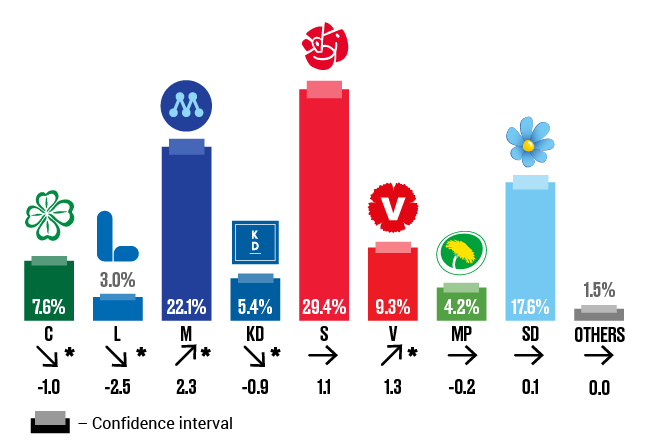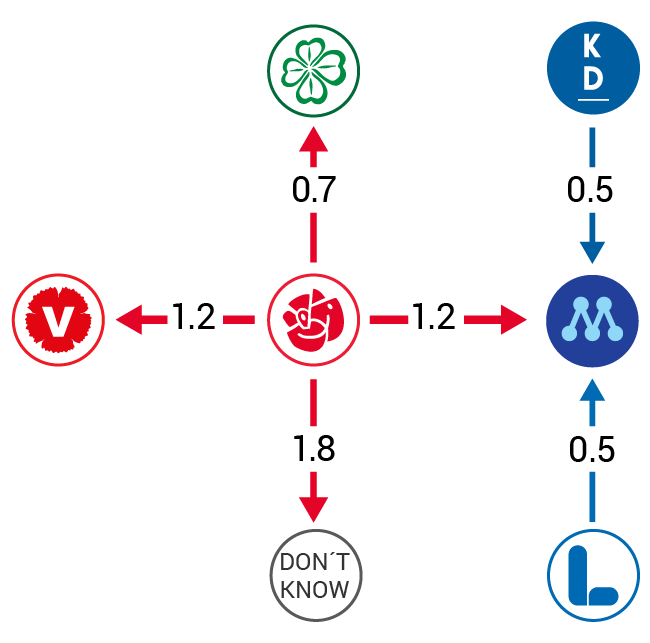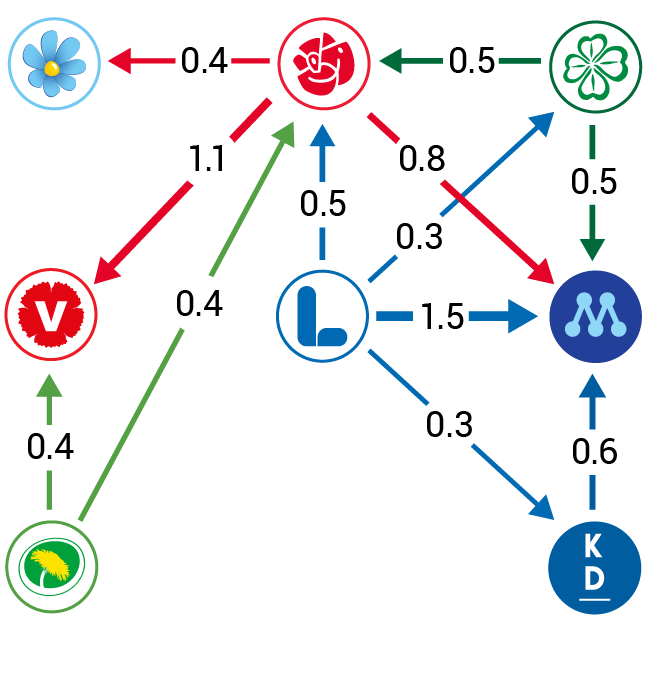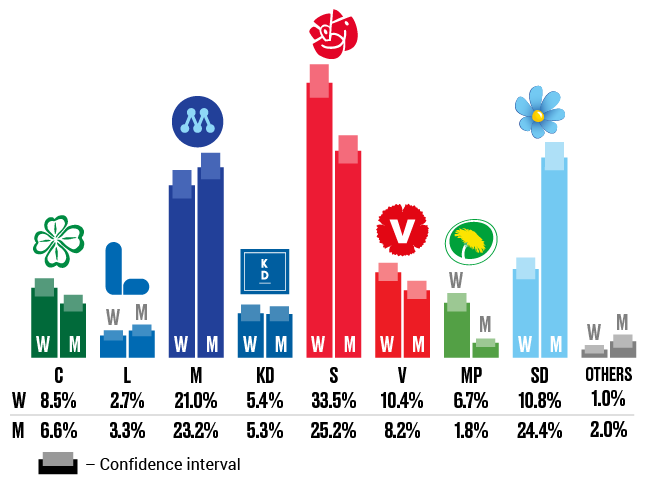Party Preference Survey in November 2020 - Election today
Political Party Preference Survey, November 2020
Statistical news from Statistics Sweden 2020-12-02 9.30
The Political Party Preference Survey presents election results if a parliamentary election were held in November 2020, as well as changes since May 2020 and since the 2018 parliamentary election.
In an election in November 2020, the votes would be cast as follows (percentage and margin of uncertainty).
Social Democratic Party: 29.4 ± 1.1 percent
Moderate Party: 22.1 ± 1.0 percent
Sweden Democrats: 17.6 ± 0.9 percent
Left Party: 9.3 ± 0.7 percent
Centre Party: 7.6 ± 0.6 percent
Christian Democrats: 5.4 ± 0.6 percent
Green Party: 4.2 ± 0.6 percent
Liberal Party: 3.0 ± 0.4 percent
Other parties: 1.5 ± 0.5 percent
The proportion of those in the electorate who were undecided was about 14 percent in November 2020.

The change refers to a comparison with the 2018 parliamentary election in percentage points. Statistically significant changes are marked with an asterisk (*).
The table below shows estimates of the parties in November 2020, in May 2020, and in the latest election. The table also shows changes from the May 2020 survey results and the 2018 parliamentary election. Statistically significant changes are marked with an asterisk (*).
Type of question: Which party would you vote for if an election were to be held in the next few days?
| Estimate November 2020 | Estimate May 2020 | ||||||
|---|---|---|---|---|---|---|---|
| Party | Percent | Margin of error | Percent | Margin of error | Change since May 2020 | Election 2018 | Change since election 2018 |
| C | 7.6 | ±0.6 | 6.0 | ±0.5 | 1.6* | 8.6 | ‑1.0* |
| L | 3.0 | ±0.4 | 3.3 | ±0.5 | ‑0.3 | 5.5 | ‑2.5* |
| M | 22.1 | ±1.0 | 20.1 | ±0.9 | 2.0* | 19.8 | 2.3* |
| KD | 5.4 | ±0.6 | 6.4 | ±0.6 | ‑1.0* | 6.3 | ‑0.9* |
| S | 29.4 | ±1.1 | 33.7 | ±1.1 | ‑4.3* | 28.3 | 1.1 |
| V | 9.3 | ±0.7 | 8.2 | ±0.6 | 1.1* | 8.0 | 1.3* |
| MP | 4.2 | ±0.6 | 4.1 | ±0.5 | 0.1 | 4.4 | ‑0.2 |
| SD | 17.6 | ±0.9 | 17.1 | ±0.8 | 0.5 | 17.5 | 0.1 |
| other | 1.5 | ±0.5 | 1.1 | ±0.3 | 0.4 | 1.5 | 0.0 |
* This change is statistically significant.
The political parties in November 2020
Changes in all political parties compared with the May 2020 survey and the September 2018 parliamentary election are described below. The flow of voters between the political parties is also described below as a percentage of the electorate. Only statistically significant flows of voters are presented.
Centre Party
If an election were held in November 2020, the Centre Party would receive 7.6 ± 0.6 percent of the votes. This is a statistically significant increase compared with May 2020, while it is a statistically significant decrease compared with the 2018 parliamentary election.
Compared with May 2020, the Centre Party has a statistically significant net gain of about 0.7 percent of the electorate from the Social Democratic Party.
Compared with the 2018 parliamentary election, a statistically significant net gain of about 0.3 percent from the Liberal Party was noted. At the same time, the Centre Party has statistically significant net losses of about 0.5 percent to the Moderate Party and about 0.5 percent to the Social Democratic Party.
Liberal Party
The Liberal Party would receive 3.0 ± 0.4 percent of the votes in an election in November 2020. This is not a statistically significant change compared with May 2020, while it is a statistically significant decrease in relation to the 2018 parliamentary election.
Compared with May 2020, the Liberal Party has a statistically significant net loss of about 0.5 percent to the Moderate Party.
In relation to the 2018 parliamentary election, the Liberal Party has statistically significant net losses of about 1.5 percent to the Moderate Party, about 0.5 percent to the Social Democratic Party, about 0.3 percent to the Centre Party, and about 0.3 percent to the Christian Democrats.
Moderate Party
If an election were held in November 2020, the Moderate Party would receive 22.1 ± 1.0 percent of the votes. This is a statistically significant increase compared with both May 2020 and the 2018 parliamentary election.
Compared with May 2020, the Moderate Party has statistically significant net gains of about 1.2 percent from the Social Democratic Party, about 0.5 percent from the Christian Democrats, and about 0.5 percent from the Liberal Party.
Compared with the 2018 parliamentary election, the Moderate Party noted statistically significant net gains of about 1.5 percent from the Liberal Party, about 0.8 percent from the Social Democratic Party, about 0.6 percent from the Christian Democrats, and about 0.5 percent from the Centre Party.
Christian Democrats
The Christian Democrats would receive 5.4 ± 0.6 percent of the votes in an election in November 2020. This is a statistically significant decrease, compared with both May 2020 and the 2018 parliamentary election.
In relation to May 2020, the Christian Democrats have a statistically significant net loss of about 0.5 percent to the Moderate Party.
Compared with the 2018 parliamentary election, a statistically significant net gain of about 0.3 percent from the Liberal Party was noted. At the same time, a statistically significant net loss of about 0.6 percent to the Moderate Party was noted.
Social Democratic Party
The Social Democratic Party would receive 29.4 ± 1.1 percent of the votes in an election in November 2020. This is a statistically significant decrease compared with May 2020, while it is not a statistically significant change compared with the 2018 parliamentary election.
Compared with May 2020, the Social Democratic Party has statistically significant net losses of about 1.8 percent to the “do not know” group, about 1.2 percent to the Moderate Party, about 1.2 percent to the Left Party, and about 0.7 percent to the Centre Party.
Compared with the 2018 parliamentary election, the Social Democratic Party noted statistically significant net gains of about 0.5 percent from the Centre Party, about 0.5 percent from the Liberal Party, and about 0.4 percent from the Green Party. At the same time, the Social Democratic Party noted statistically significant net losses of about 1.1 percent to the Left Party, about 0.8 percent to the Moderate Party, and about 0.4 percent to the Sweden Democrats.
Left Party
If an election were held in November 2020, the Left Party would receive 9.3 ± 0.7 percent of the votes. This is a statistically significant increase compared with both May 2020 and the 2018 parliamentary election.
Compared with May 2020, the Left Party noted a statistically significant net gain of about 1.2 percent from the Social Democratic Party.
Compared with the 2018 parliamentary election, the Left Party has statistically significant net gains of about 1.1 percent from the Social Democratic Party and about 0.4 percent from the Green Party.
Green Party
If an election were held in November 2020, the Green Party would receive 4.2 ± 0.6 percent of the votes. This is not a statistically significant change, neither compared with May 2020 nor with the 2018 parliamentary election.
Compared with the 2018 parliamentary election, the Green Party noted statistically significant net losses of about 0.4 percent to the Social Democratic Party and about 0.4 percent to the Left Party.
Sweden Democrats
The Sweden Democrats would receive 17.6 ± 0.9 percent of the votes in an election in November 2020. This is not a statistically significant change, neither compared with May 2020 nor with the 2018 parliamentary election.
Compared with the 2018 parliamentary election, the Sweden Democrats noted a statistically significant net gain of about 0.4 percent from the Social Democratic Party.
Other parties
The “other parties” group would receive 1.5 ± 0.5 percent of the votes in an election in November 2020. This is not a statistically significant change, neither compared with May 2020 nor with the 2018 parliamentary election.

* Figure 1 illustrates statistically significant net flows from May 2020 to November 2020 between the various political parties. The figures indicate significant net gains and net losses as a percentage of the electorate. The flows are based on all those who stated which party they would vote for or answered “do not know” when asked which party they would vote for in an election in each survey round. The flows cannot be used to calculate total changes in parties’ proportion of voters compared with May 2020, because only statistically significant flows are presented and because there are flows between parties and the “do not know” group. (Unweighted information is available in table 22 in the table published on 8 December.)

* Figure 2 illustrates statistically significant net flows in the electorate from the 2018 parliamentary election to November 2020 between the different political parties. The figures indicate significant net gains and net losses as a percentage of the electorate. The flows are based on the answers of all the respondents in the survey who stated which party they voted for in the 2018 parliamentary election and which party they would vote for in an election in November 2020. The flows cannot be used to calculate total changes in parties’ proportion of voters compared with the 2018 election, because only statistically significant flows are presented and because there are flows between parties and the “do not know” group. (Unweighted information is available in table 21 in the table published on 8 December.)

| Women | Men | Total | |||||
|---|---|---|---|---|---|---|---|
| Party | Percent | Margin of error | Percent | Margin of error | Percent | Margin of error | |
| C | 8.5 | ±1.1 | 6.6 | ±1.0 | 7.6 | ±0.6 | |
| L | 2.7 | ±0.6 | 3.3 | ±0.7 | 3.0 | ±0.4 | |
| M | 21.0 | ±1.7 | 23.2 | ±1.6 | 22.1 | ±1.0 | |
| KD | 5.4 | ±1.0 | 5.3 | ±0.9 | 5.4 | ±0.6 | |
| S | 33.5 | ±2.0 | 25.2 | ±1.7 | 29.4 | ±1.1 | |
| V | 10.4 | ±1.1 | 8.2 | ±1.1 | 9.3 | ±0.7 | |
| MP | 6.7 | ±1.1 | 1.8 | ±0.5 | 4.2 | ±0.6 | |
| SD | 10.8 | ±1.3 | 24.4 | ±1.7 | 17.6 | ±0.9 | |
| others | 1.0 | ±0.5 | 2.0 | ±0.8 | 1.5 | ±0.5 | |
| C | L | M | KD | S | V | MP | SD | Other | |||||||||||
|---|---|---|---|---|---|---|---|---|---|---|---|---|---|---|---|---|---|---|---|
| Region | % | ± | % | ± | % | ± | % | ± | % | ± | % | ± | % | ± | % | ± | % | ± | |
| Sydsverige | 6.9 | ±2.0 | 3.1 | ±1.2 | 23.2 | ±3.5 | 3.7 | ±1.6 | 28.4 | ±4.0 | 6.1 | ±1.8 | 5.3 | ±2.3 | 22.6 | ±3.4 | 0.7 | ±0.6 | |
| Småland med öarna | 10.4 | ±3.0 | 1.2 | ±0.9 | 20.9 | ±4.0 | 7.9 | ±2.8 | 27.3 | ±4.7 | 8.8 | ±3.1 | 3.9 | ±1.8 | 17.0 | ±3.9 | 2.6 | ±2.4 | |
| Västsverige | 8.1 | ±1.9 | 2.5 | ±1.1 | 20.6 | ±2.6 | 6.2 | ±1.5 | 29.6 | ±3.1 | 8.7 | ±1.8 | 4.6 | ±1.7 | 18.5 | ±2.8 | 1.1 | ±0.7 | |
| Stockholm County, excluding Stockholm municipality | 5.4 | ±1.8 | 2.7 | ±1.2 | 28.9 | ±3.8 | 6.9 | ±2.5 | 26.8 | ±4.3 | 7.6 | ±2.3 | 4.1 | ±1.6 | 17.0 | ±3.4 | .. | .. | |
| Stockholm municipality | 8.3 | ±2.6 | 5.4 | ±2.2 | 20.7 | ±3.9 | 2.5 | ±1.4 | 26.8 | ±4.4 | 18.3 | ±3.5 | 7.7 | ±2.3 | 8.6 | ±2.8 | 1.7 | ±1.2 | |
| Östra Mellansverige | 6.9 | ±1.8 | 3.3 | ±1.2 | 24.9 | ±3.2 | 5.3 | ±1.6 | 26.0 | ±3.2 | 9.8 | ±2.1 | 3.9 | ±1.3 | 17.5 | ±3.0 | 2.3 | ±1.6 | |
| Norra Mellansverige | 6.3 | ±2.5 | 2.7 | ±1.5 | 17.6 | ±3.9 | 6.3 | ±2.4 | 35.4 | ±5.4 | 9.4 | ±2.9 | 1.4 | ±1.0 | 19.3 | ±4.2 | 1.7 | ±1.4 | |
| Mellersta och övre Norrland | 9.5 | ±3.1 | 2.8 | ±1.5 | 16.0 | ±4.0 | 4.0 | ±1.8 | 39.1 | ±5.2 | 8.8 | ±2.6 | 1.6 | ±1.1 | 16.3 | ±4.0 | .. | .. | |
| Total | 7.6 | ±0.6 | 3.0 | ±0.4 | 22.1 | ±1.0 | 5.4 | ±0.6 | 29.4 | ±1.1 | 9.3 | ±0.7 | 4.2 | ±0.6 | 17.6 | ±0.9 | 1.5 | ±0.5 | |
Description of the regions
Sydsverige: Blekinge County and Skåne County
Småland med öarna: Jönköping County, Kronoberg County, Kalmar County and Gotland County
Västsverige: Halland County and Västra Götaland County
Östra Mellansverige: Uppsala County, Södermanland County, Östergötland County, Örebro County and Västmanland County
Norra Mellansverige: Värmland County, Dalarna County and Gävleborg County
Mellersta och övre Norrland: Västernorrland County, Jämtland County, Västerbotten County and Norrbotten County
A table of regional survey results from the current and the previous electoral period is available in Statistics Sweden’s Statistical Database.
Definitions and explanations
The Party Preference Survey in November 2020 was conducted with a national random sample consisting of 9 173 persons entitled to vote in a parliamentary election, without an upper age limit. Answers from these people are collected through telephone interviews and online questionnaires. As in previous surveys, all available telephone numbers, both to mobile phones and fixed phones, have been used to contact the selected persons.
Among the sample persons, 28.7 percent could not be reached, 2.5 percent were unable to participate, and 17.6 percent did not want to be participate. The total non-response rate was 48.8 percent. The total number of respondents was 4 692, which corresponds to 51.2 percent. A more detailed presentation of non-response will be made available in connection with the publication on 8 December.
The data was collected during the period from 2 November to 26 November.
The results are presented in the form of point estimates ± margins of uncertainty. The interval that is formed by the percent estimate ± margin of uncertainty here is a 95 percent uncertainty interval, which is an interval that, with 95 percent probability, includes the actual value of the population, if no systematic errors occur.
Adjustment of estimation method
In May 2020, an adjusted method was implemented into the Political Party Preference Survey as a result of Statistics Sweden’s ongoing quality improvement of the survey.
The objective of the method adjustment was to adapt the estimation method to a larger non-response and to improve the precision of the estimates. In addition, this change improved comparability between the Election today estimate and the Political party preference estimate.
In connection with the publication in May, the Statistical Database at Statistics Sweden was also updated with recalculated estimates from November 2010 and onward. This enables comparisons over time without having to take into account the method adjustment.
Further information on the adjustments is available at Justerad skattningsmetod i Partisympatiundersökningen – En beskrivning av de metodjusteringar som implementerats i maj 2020 (pdf).
Next publishing will be
On 8 December, information about political party preferences in November 2020 will be published, in total and by demographic group. Statistics Sweden has opted to split up the Political Party Preference Survey results to make it possible to publish “Election today estimate” as quickly as possible after completed data collection, and also to make it clear that there are two different measurements involved. “Election today estimate” is measured using the question “Which party would you vote for if a parliamentary election was held in the next few days?” while the political party preference is measured using the questions “Do you prefer one of the political parties more than the others?” and “Which party do you prefer the most?”.
The publication on 8 December will also contain information about EU and euro preferences, in total and by demographic group.
Statistical Database
More information is available in the Statistical Database
Feel free to use the facts from this statistical news but remember to state Source: Statistics Sweden.
